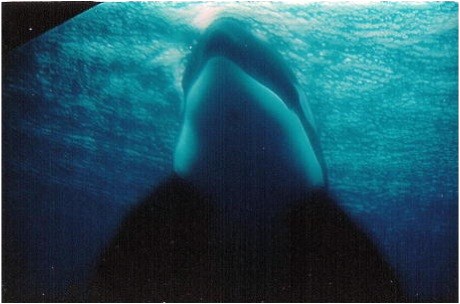
I took the above picture of Keiko the killer whale a couple of weeks after he was moved from his aging tank in Mexico to his then-new rehab center at the Oregon Coast Aquarium in Newport. He was grooving on his new wide-open spaces, but they were already working on making him not so attached to humans, and he hadn't had any visitors except his trainers for awhile. He definitely was checking me out, and he saw that I had a camera. He loved cameras.
You could say that the camera loved Keiko, too, because he looked awfully good in Free Willy, which indeed would have been (and is in every other respect) a bleah Hollywood kids' flick but for the orca's vivid presence. After seeing him a few times, I thought it actually had worked the other way around. He was a charismatic orca who was very attuned to humans (at least partially the product, no doubt, of having been captured while still young). I think the film succeeded in large part because his rather warm and playful personality came through on film.
A true story: The scene in the film in which Willy rescues the boy, Jesse, from the bottom of the pool was not in the original script, but was based on something Keiko did in real life. The young daughter of the owner of the aquarium in Mexico where he resided for many years (and where much of the film was made) fell in, unnoticed, during a performance. No one was aware of it, in fact, until Keiko nudged her up and out of the water and to the side of the pool. The film's director heard the story from the pool owners and decided to write it into the script; when asked to recreate the performance with a Jesse dummy, Keiko pulled it off on the first shot.
The thing about orcas like Keiko, of course, is that they are attuned so well to humans that it is easy to anthropomorphize them, which is something of an insult; it denies them their whale-ness. But I gather that even during the "release into the wild" sessions in Iceland, he was reluctant to sever his ties with humans. Which is probably why he showed up in Norway and adopted a local village full of humans.
When he died of pneumonia at the age of 27 yesterday, I was of course sad to read about it. But he lived a long life for a captive male. And in his last years, there's no doubt he enjoyed a better quality of life than most of his preceding years. He was healthy, and seemed happy, the reports say.
I think that, as animals go, he was more important than most of the creatures who populate our big screens and our cultural iconography, because he was a great ambassador for his species -- and for that matter all of animalkind. The image of the threatening killer whale was forever shattered after Free Willy, and the gentle intelligence of the animals was imbedded permanently in the popular imagination. And he became a symbol of something new in humans too -- a clearer understanding of, even a sympathy for, the needs and rights of wild animals. No doubt some would declare that crass sentimentality or "pussy" behavior. Screw them.
No comments:
Post a Comment